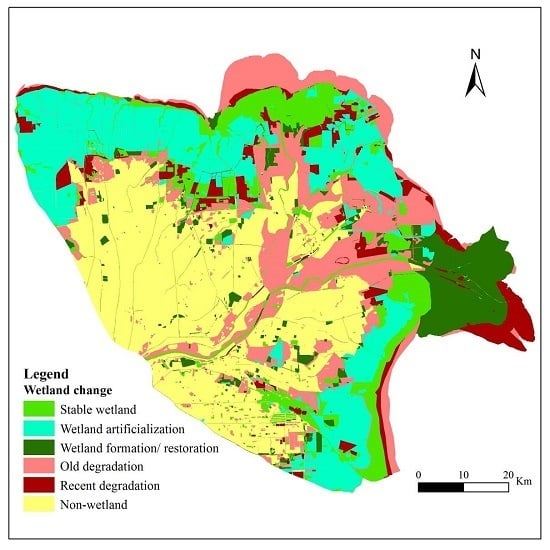Understanding Land Use and Land Cover Dynamics from 1976 to 2014 in Yellow River Delta
Abstract
:1 Introduction
2. Study Area and Methods
2.1. Study Area
2.2. Data Preparation and Acquisition
2.2.1. Satellite Image Selection and Pre-Processing
2.2.2. Region Definition, Land Use Classification, and Accuracy Assessment
2.3. Quantification of LUCC Based on Transition Matrix
2.3.1. Land Use Transition Matrix
2.3.2 Annual Rate of Change
2.3.3. Stability Grade
2.3.4. Swap Change (SW) Percentage
2.3.5. Selection of Main Transition
2.4. Trajectories of Wetland Change
3. Results
3.1. Accuracy Assessment
3.2. Temporal Patterns for Changes in Land Use
3.3. Dynamic Analysis of Changes in Land Use
3.3.1. Stability Grade
3.3.2. Swap Change
3.3.3. Main Transitions
3.4. Trajectory of Wetland Change
4 Discussion
5. Conclusions
Acknowledgments
Author Contributions
Conflicts of Interest
Abbreviations
| YRD | Yellow River Delta |
| LUCC | Land use/cover change |
| KC | Kappa coefficient |
| SG | Stability grade |
| SW | Swap change |
| BC | Beach |
| GL | Grassland |
| BL | Bushland |
| RV | River |
| DP | Ditch and ponds |
| AS | Aquafarm and salt pan |
| WL | Woodland |
| CL | Cultivated land |
| AL | Construction land |
| SF | Sea surface |
References
- Turner, B.L., II; Skole, D.; Sanderson, S.; Fischer, G.; Fresco, L.; Leemans, R. Land-Use and Land-Cover Change-Science/Research Plan; IGBP Report No.35 and HDP Report No.7; IGBP and HDP Secretariats: Stochkholm, Sweden; Geneva, Switzerland, 1995. [Google Scholar]
- Houghton, R.A.; Hackler, J.L.; Lawrence, K.T. The US carbon budget: Contribution from land use change. Science 1999, 285, 574–578. [Google Scholar] [CrossRef] [PubMed]
- Shi, P.J.; Gong, P.; Li, X.B. Methods and Practice of Land Use Changes in Research; Science Press: Beijing, China, 2000. (In Chinese) [Google Scholar]
- Lawrence, P.L.; Chase, T.N. Investigating the climate impacts of global land cover change in the community climate system model. Int. J. Clim. 2010, 30, 2066–2087. [Google Scholar] [CrossRef]
- Liu, J.Y.; Liu, M.L.; Deng, X.Z.; Zhuang, D.F.; Zhang, Z.X.; Luo, D. The land use and land cover change database and its relative studies in China. J. Geogr. Sci. 2002, 12, 275–282. [Google Scholar]
- Dewan, A.M.; Yamaguchi, Y.; Rahman, M.Z. Dynamics of land use/cover changes and the Analysis of Landscape fragmentation in Dhaka Metropolitan, Bangladesh. GeoJournal 2012, 77, 315–330. [Google Scholar] [CrossRef]
- Antrop, M. Why landscapes of the past are important for the future. Landsc. Urban Plan. 2005, 70, 21–34. [Google Scholar] [CrossRef]
- Hasse, J.E.; Lathrop, R.G. Land resource impact indicators of urban sprawl. Appl. Geogr. 2003, 23, 159e175. [Google Scholar] [CrossRef]
- Tavares, A.O.; Pato, R.L.; Magalhães, M.C. Spatial and temporal land use change and occupation over the last half century in a peri-urban area. Appl. Geogr. 2012, 34, 432–444. [Google Scholar] [CrossRef]
- Li, S.N.; Wang, G.X.; Deng, W.; Hu, Y.M.; Hu, W.W. Influence of hydrology process on wetland landscape pattern: A case study in the Yellow River Delta. Ecol. Eng. 2009, 35, 1719–1726. [Google Scholar] [CrossRef]
- Pontius, R.G., Jr.; Shusas, E.; McEachern, M. Detecting important categorical land changes while accounting for persistence. Agric. Ecosyst. Environ. 2004, 101, 251–268. [Google Scholar] [CrossRef]
- Braimoh, A.K. Random and systematic land-cover transitions in northern Ghana. Agric. Ecosyst. Environ. 2006, 113, 254–263. [Google Scholar] [CrossRef]
- Lambin, E.F.; Geist, H.J.; Lepers, E. Dynamics of land-use and land-cover change in tropical regions. Ann. Rev. Environ. Resour. 2003, 28, 205–241. [Google Scholar] [CrossRef]
- Lu, D.; Mausel, P.; Brondízio, E.; Moran, E. Change detection techniques. Int. J. Remote Sens. 2004, 25, 2365–2407. [Google Scholar] [CrossRef]
- Pontius, R.G.; Petrova, S.H. Assessing a predictive model of land change using uncertain data. Environ. Model. Softw. 2010, 25, 299–309. [Google Scholar] [CrossRef]
- Manandhar, R.; Odeh, I.O.A.; Pontius, R.G. Analysis of twenty years of categorical land transitions in the lower hunter of new South Wales, Australia. Agric. Ecosyst. Environ. 2010, 135, 336–346. [Google Scholar] [CrossRef]
- Isabel, P.; Cunha, M.; Pereira, L. Remote sensing based indicators of changes in a mountain rural landscape of northeast Portugal. Appl. Geogr. 2011, 31, 871–880. [Google Scholar]
- Johnson, B.G.; Zuleta, G.A. Land-use land-cover change and ecosystem loss in the Espinal ecoregion, Argentina. Agric. Ecosyst. Environ. 2013, 181, 31–40. [Google Scholar] [CrossRef]
- Liu, R.; Zhu, D.L. Methods for detecting land use changes based on the land use transition matrix. Resour. Sci. 2010, 32, 1544–1550. [Google Scholar]
- Zhou, Q.; Li, B.; Kurban, A. Trajectory analysis of land cover change in arid environment of China. Int. J. Remote Sens. 2008, 29, 1093–1107. [Google Scholar] [CrossRef]
- Wang, H.; Gao, Y.; Pu, R.L.; Ren, L.L.; Kong, Y.; Li, H.; Li, L. Natural and anthropogenic influences on a red-crowned crane habitat in the Yellow River Delta Natural Reserve, 1992–2008. Environ. Monit. Assess. 2014, 186, 4013–4028. [Google Scholar] [CrossRef] [PubMed]
- Wang, H.; Gao, Y.; Pu, R.L.; Ren, L.L.; Kong, Y.; Li, H.; Li, L. Assessment of the red-crowned crane habitat in the Yellow River Delta Nature Reserve, East China. Reg. Environ. Chang. 2012, 31, 115–123. [Google Scholar] [CrossRef]
- Bi, X.L.; Wang, B.; Lu, Q.S. Fragmentation effects of oil wells and roads on the Yellow River Delta, North China. Ocean Coast Manag. 2011, 54, 256–264. [Google Scholar] [CrossRef]
- Fan, H.; Huang, H.J. Response of coastal marine eco-environment to river fluxes into the sea: A case study of the Huanghe (Yellow) River mouth and adjacent waters. Mar. Environ. Res. 2008, 65, 378–387. [Google Scholar] [CrossRef] [PubMed]
- He, X.H.; Hörmann, G.; Strehmel, A.; Guo, H.L.; Fohrer, N. Natural and Anthropogenic Causes of Vegetation Changes in Riparian Wetlands Along the Lower Reaches of the Yellow River, China. Wetlands 2015, 35, 391–399. [Google Scholar] [CrossRef]
- Kong, D.X.; Miao, C.Y.; Borthwick, A.G.L.; Duan, Q.Y.; Liu, H.; Sun, Q.H.; Ye, A.Z.; Di, Z.H.; Gong, W. Evolution of the Yellow River Delta and its relationship with runoff and sediment load from 1983 to 2011. J. Hydrol. 2015, 520, 157–167. [Google Scholar] [CrossRef]
- Zong, X.Y. Study on Dynamic Changes of Wetland Landscape Pattern in Yellow River Delta. J. Geo-inf. Sci. 2009, 11, 91–97. [Google Scholar] [CrossRef]
- Sun, X.Y.; Su, F.Z.; Lv, T.T. Analysis of temporal-spatial changes in wetlands over the Yellow River estuary. Resour. Sci. 2011, 33, 2277–2284. [Google Scholar]
- Zhang, B.L.; Yin, L.; Zhang, S.M.; Feng, C.Y. Assessment on characteristics of LUCC process based on complex network in Modern Yellow River Delta, Shandong Province of China. Earth Sci. Inform. 2016, 9, 83–93. [Google Scholar] [CrossRef]
- Zhang, X.L.; Ye, S.Y.; Yin, P. Characters and successions of natural wetland vegetation in Yellow River Delta. Ecol. Environ. Sci. 2009, 18, 292–298. [Google Scholar]
- Li, S.N.; Wang, G.X.; Deng, W.; Hu, Y.M. Effects of runoff and sediment variation on landscape pattern in the Yellow River Delta of China. Adv. Water Sci. 2009, 20, 325–331. [Google Scholar]
- Zhang, X.L.; Li, P.; Liu, L.J.; Li, P.Y. Degradation assessment of Modern Yellow River Delta coastal wetland. Mar. Sci. Bull. 2010, 29, 685–689. [Google Scholar]
- Hong, J.; Lu, X.N.; Wang, L.L. Quantitative analysis of the factors driving evolution in the Yellow River Delta Wetand in the past 40 years. Acta Ecol. Sin. 2016, 36, 924–935. [Google Scholar]
- Ottinger, M.; Kuenzer, C.; Liu, G.H.; Wang, S.Q.; Dech, S. Monitoring land cover dynamics in the Yellow River Delta from 1995 to 2010 based on Landsat 5 TM. Appl. Geogr. 2013, 44, 53–68. [Google Scholar] [CrossRef]
- Fang, H.; Liu, G.; Kearney, M. Georelational analysis of soil type, soil salt content, landform, and land use in the Yellow River Delta, China. Environ. Manag. 2005, 35, 72–83. [Google Scholar] [CrossRef]
- Xu, J.X. A study of thresholds of runoff and sediment for the land accretion of the Yellow River Delta. Geogr. Res. 2002, 21, 163–170. [Google Scholar]
- Zhao, X.S.; Cui, B.S.; Sun, T.; He, Q. The relationship between the spatial distribution of vegetation and soil environmental factors in the tidal creek areas of the Yellow River Delta. Ecol. Environ. Sci. 2010, 19, 1855–1861. [Google Scholar]
- Yu, J.B.; Chen, X.B.; Sun, Z.G.; Xie, W.J.; Mao, P.L.; Wu, C.F.; Dong, H.F.; Mu, X.J.; Li, Y.Z.; Guan, B.; et al. The spatial distribution characteristics of soil nutrients in new-born coastal wetland in Yellow River delta. Acta Sci. Circumst. 2010, 30, 855–861. [Google Scholar]
- Kuenzer, C.; Ottinger, M.; Liu, G.H.; Sun, B.; Baumhauer, R.; Dech, S. Earth observation-based coastal zone monitoring of the Yellow River Delta: Dynamics in China's second largest oil producing region overfour decades. Appl. Geogr. 2014, 55, 92–107. [Google Scholar] [CrossRef]
- Teferi, E.; Bewket, W.; Uhlenbrook, S.; Wenninger, J. Understanding recent land use and land cover dynamics in the source region of the Upper Blue Nile, Ethiopia: Spatially explicit statistical modeling of systematic transitions. Agric. Ecosyst. Environ. 2013, 165, 98–117. [Google Scholar] [CrossRef]
- Wan, H. Research on Wetland Information Extraction and Analysis of Yellow River Delta Based on RS and GIS; China University of Petroleum (East China): Dongying, China, 2009. [Google Scholar]
- Liu, G.L.; Zhang, L.C.; Zhang, Q.; Musyimi, Z.; Jiang, Q.H. Spatio–temporal dynamics of wetland landscape patterns based on remote sensing in Yellow River Delta,China. Wetlands 2014, 34, 787–801. [Google Scholar] [CrossRef]
- Lavery, P.; Pattiaratchi, C.; Wyllie, A.; Hick, P. Water-Quality Monitoring in Estuarine Waters Using the Landsat Thematic Mapper. Remote Sens. Environ. 1993, 46, 268–280. [Google Scholar] [CrossRef]
- Fan, Y.; Zhang, S.; Hou, C.; Zhang, L. Study on Method of Coastline Extraction from Remote Sensing—Taking Yellow River Mouth Reach and Diaokou Reach of Yellow River Delta Area as an Example. Remote Sens. Inform. 2009, 8, 67–70. [Google Scholar]
- Piwowar, J.M. Digital Image Analysis. In Remote Sensing for GIS Managers; Aronoff, S., Ed.; ESRI Press: Redlands, CA, USA, 2005. [Google Scholar]
- Ke, C.Q.; Zhang, D.; Wang, F.Q.; Chen, S.X.; Schmullius, C.; Boerner, W.M.; Wang, H. Analyzing coastal wetland change in the Yancheng National Nature Reserve, China. Reg. Environ. Chang. 2011, 11, 161–173. [Google Scholar] [CrossRef]
- Liu, J.Y.; Liu, M.L.; Tian, H.Q.; Zhuang, D.F.; Zhang, Z.X.; Zhang, W.; Tang, X.M.; Deng, X.Z. Spatial and temporal patterns of China’s cropland during 1990–2000: An analysis based on Landsat TM data. Remote Sens. Environ. 2005, 98, 442–456. [Google Scholar] [CrossRef]
- Wang, W.J.; Zhang, C.R.; Allen, J.M.; Li, W.D.; Boyer, M.A.; Segerson, K.; Silander, J.A., Jr. Analysis and prediction of land use changes related to invasive species and major driving forces in the state of Connecticut. Land 2016, 5, 25. [Google Scholar] [CrossRef]
- Ni, J.R.; Yin, K.Q.; Zhao, Z.J. Comprehensive classification for wetlands I. Classification. J. Nat. Resour. 1998, 13, 214–221. [Google Scholar]
- Zhao, H.T.; Wang, L.R. Coastal wetland types in China. Mar. Sci. Bull. 2000, 19, 72–81. [Google Scholar]
- Tang, X.P.; Huang, G.L. Study on classification system for wetland types in China. For. Res. 2003, 16, 531–539. [Google Scholar]
- Foody, G.M. Status of land cover classification accuracy assessment. Remote Sens. Environ. 2002, 80, 185–201. [Google Scholar] [CrossRef]
- Stehman, S.V. Selecting and interpreting measures of thematic classification accuracy. Remote Sens. Environ. 1997, 62, 77–89. [Google Scholar] [CrossRef]
- Aldwaik, S.Z.; Pontius, R.G. Intensity analysis to unify measurements of size and stationarity of land changes by interval, category, and transition. Landsc. Urban Plan. 2012, 106, 103–114. [Google Scholar] [CrossRef]
- Swetnam, R.D. Rural land use in England and Wales between 1930 and 1998: Mapping trajectories of change with a high resolution spatio-temporal dataset. Landsc. Urban Plan. 2007, 81, 91–103. [Google Scholar] [CrossRef]
- Wang, D.C.; Gong, J.H.; Chen, L.D.; Zhang, L.H.; Song, Y.Q.; Yue, Y.J. Spatio-temporal pattern analysis of land use/cover change trajectories in Xihe watershed. Int. J. Appl. Earth Obs. Geoinf. 2012, 4, 12–21. [Google Scholar] [CrossRef]
- Chen, J.; Wang, S.Y.; Mao, Z.P. Monitoring wetland changes in Yellow River Delta by remote sensing during 1976–2008. Prog. Geogr. 2011, 30, 585–592. [Google Scholar]
- Wang, Y.L.; Yu, J.B.; Dong, H.F.; Li, Y.Z.; Zhou, D.; Fu, Y.Q.; Han, G.X.; Mao, P.L. Spatial Evolution of Landscape Pattern of Coastal Wetlands in Yellow River Delta. Sci. Geogr. Sin. 2012, 32, 717–724. [Google Scholar]
- Higgins, S.; Overeem, I.; Tanaka, A.; Syvitski, J.P.M. Land subsidence at aquaculture facilities in the Yellow River delta, China. Featur. Geophys. Res. Lett. 2013, 40, 3898–3902. [Google Scholar] [CrossRef]

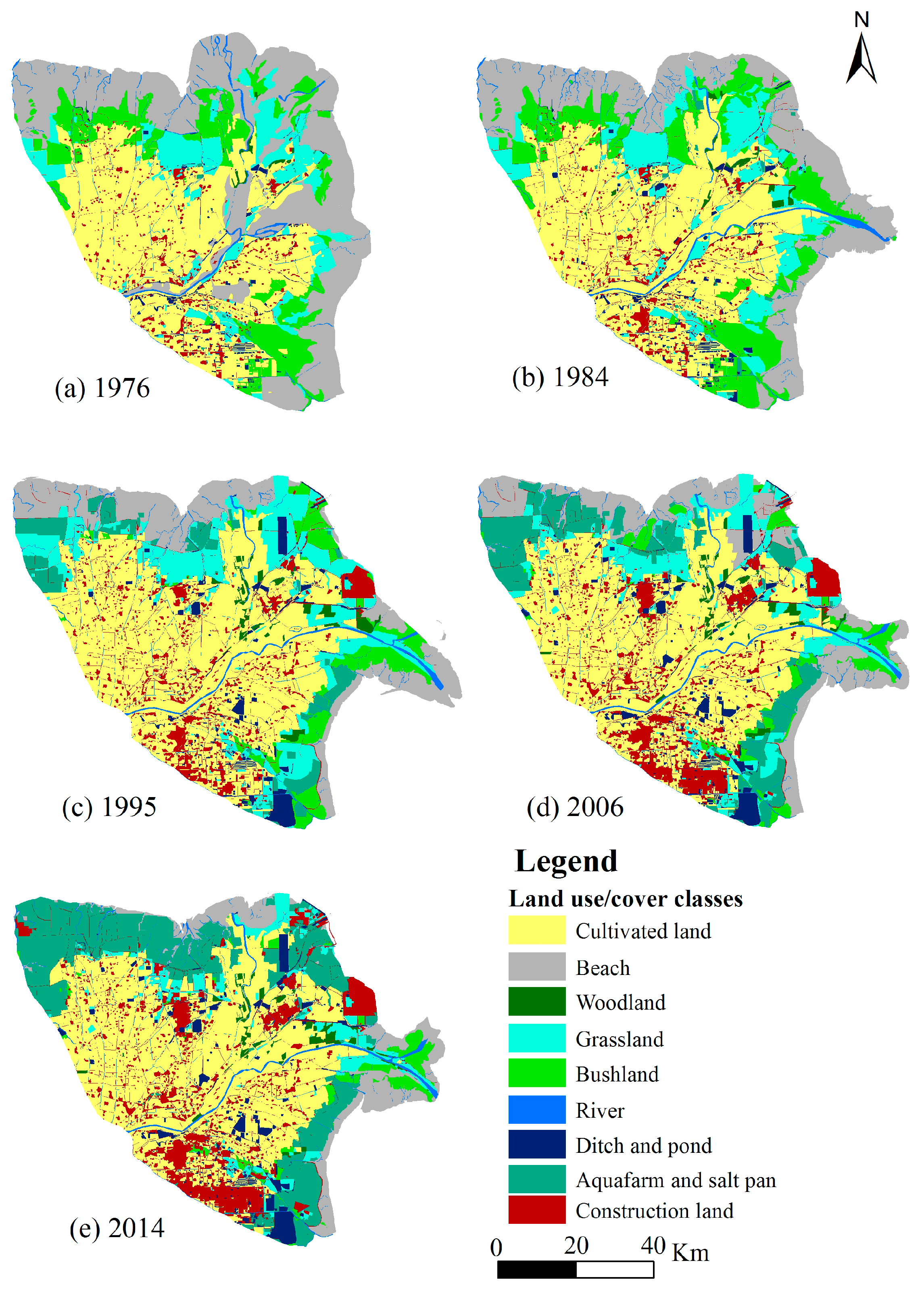
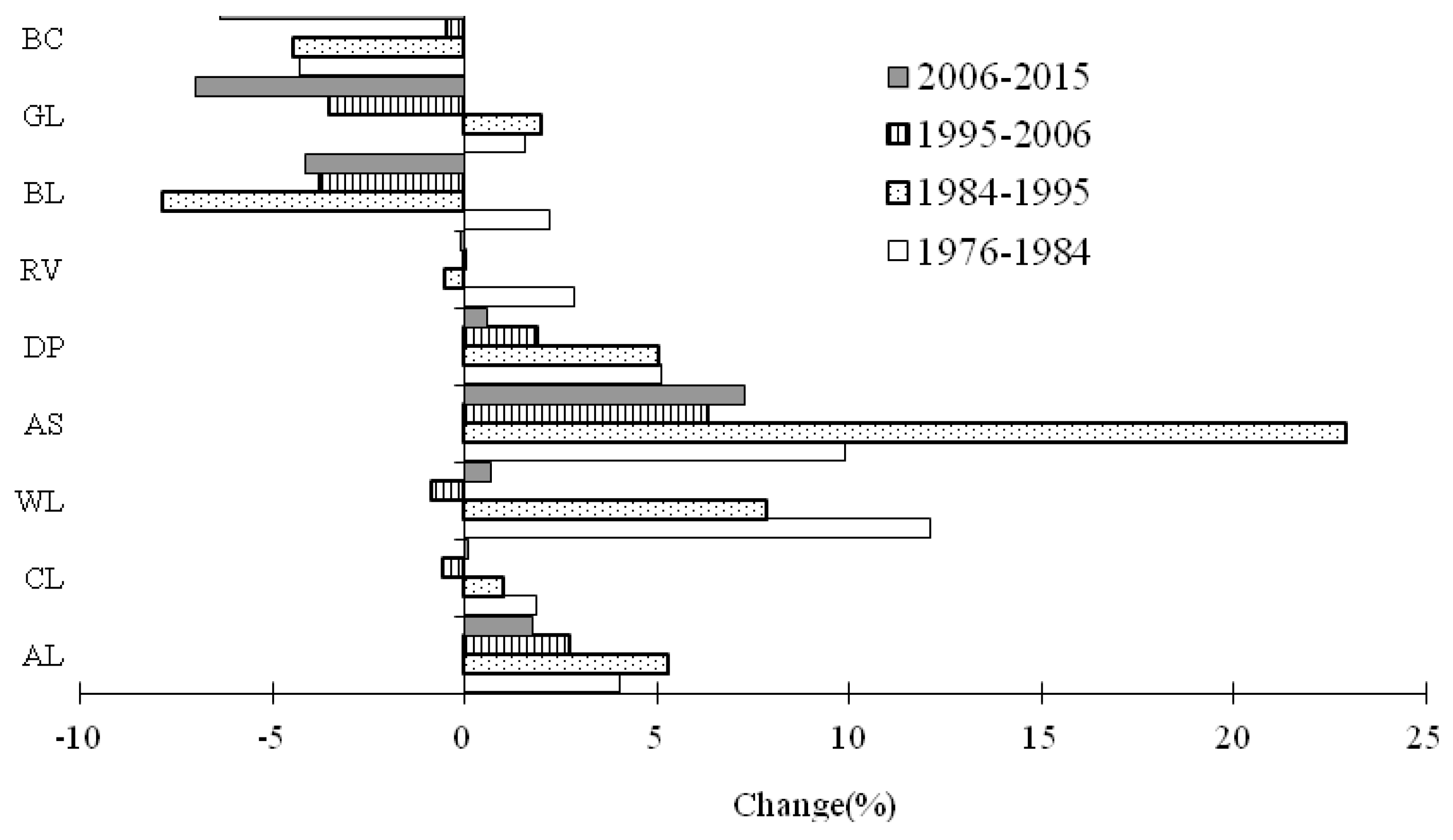

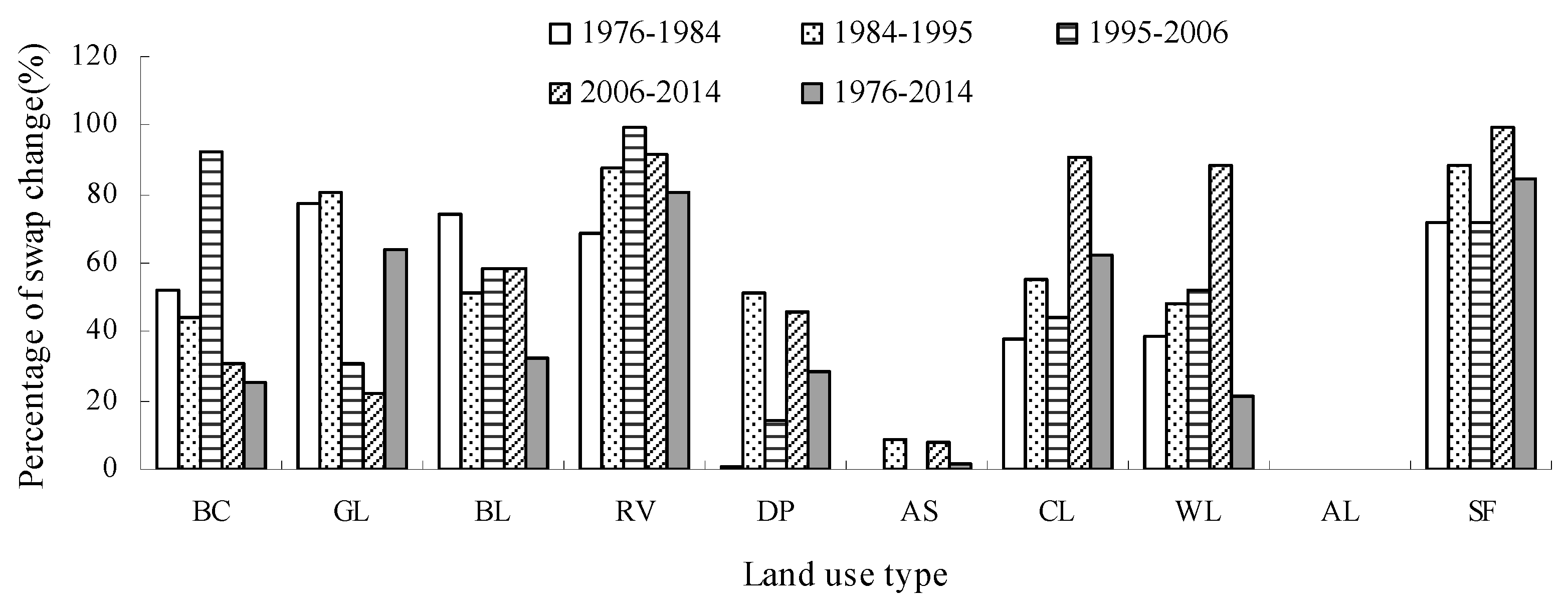
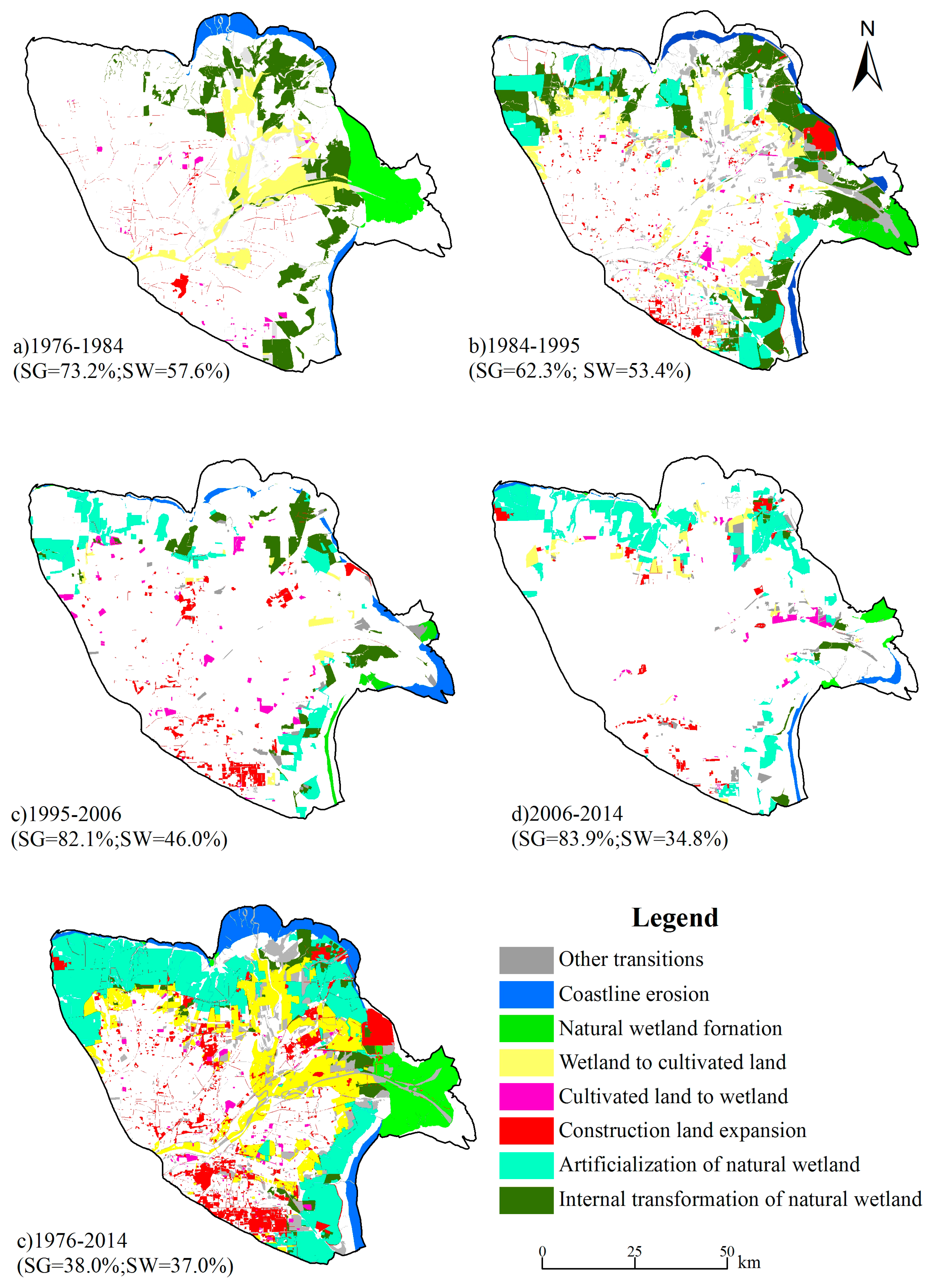
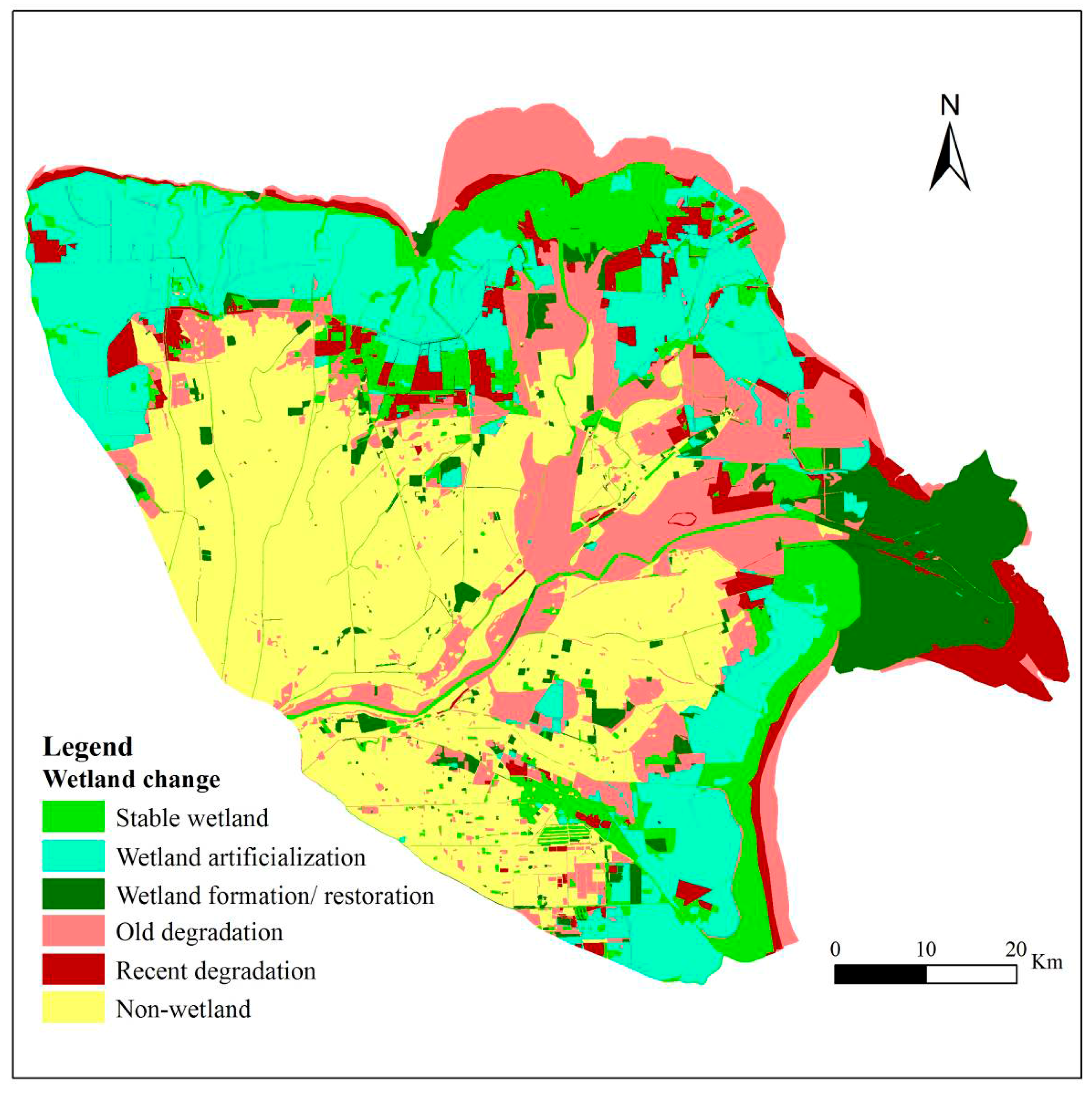
| Platform | Sensor | Path/Row | Resolution(m) | AcquisitionDate |
|---|---|---|---|---|
| Landsat 2 | Multispectral Scanner | 130–134 | 90 | 2 June 1976 |
| Landsat 5 | Thematic Mapper | 121–134 | 30 | 5 November 1984 |
| Landsat 5 | Thematic Mapper | 121–134 | 30 | 18 September 1995 |
| Landsat 5 | Enhanced Thematic Mapper | 121–134 | 15 | 2 November 2006 |
| Landsat 8 | Operational Land Imager | 121–134 | 30 | 11 May 2014 |
| Land Use Type | Land Use Class | Description | Code |
|---|---|---|---|
| Natural wetland | Beach | Mucky, sandy, and gravel beach located between the estuary and tidal zone | BC |
| Grassland | Reeds, cattails (Typha orientalis), and other water-loving plant community members located in rivers and estuaries, reservoirs, and lakes of flood land | GL | |
| Bushland | Mainly Tamarix bush combined with the alkaline meadows such as Suaeda heteroptera, Salicornia, and Suaeda sals | BL | |
| River | Permanent and seasonal rivers including their floodplains | RV | |
| Artificial wetland | Ditch and ponds | A natural or artificial pond or lake used for the storage and regulation of water, including lake, reservoirs, and ponds | DP |
| Aquafarm and salt pan | Artificial built around shrimp, crabs and other aquatic ponds, etc.; Salt field in coastal areas and near estuaries | AS | |
| Non-wetland | Woodland | Woodland composed of Populus, Salix, Black locust (Robinia pseudoacacia) and Salix (Salix integra) | WL |
| Cultivated land | Arable land that is worked by plowing and sowing and raising crops | CL | |
| Construction land | Man-made impervious surface such as roads, urban, and rural residential land, industrial land, oil field infrastructure, etc. | AL |
| T2 | Ai+ | Loss | |||||
|---|---|---|---|---|---|---|---|
| L1 | L2 | . . . | Ln | ||||
| T1 | L1 | A11 | A12 | . . . | A1n | A1+ | A1+ − A11 |
| L2 | A21 | A22 | . . . | A2n | A2+ | A2+ − A22 | |
| . . | . . | . . | . . | . . | . . | . . | |
| Ln | An1 | An2 | . . . | Ann | An+ | An+ − Ann | |
| A+i | A+1 | A+2 | . . . | A+n | |||
| Gain | A+1 − A11 | A+2 − A22 | . . . | A+n − Ann | |||
| No. | Description | Trajectories * |
|---|---|---|
| 1 | Stable wetland | WWWWW, RRRRR |
| 2 | wetland formation/restoration | NNNNR, NNNNW, NNNRR, NNNWW, NNRRR, NNWWW, NRRRR, NWWWW, NWNNW, NWNWW, NWWNW, NWWWW, RRNWW, WNNWW, WNWNW, WNWWW, WWNNW, WWNRR, WWRNR |
| 3 | Wetland artificialization | NNNWR, NNWRR, NWNWR, NWRRR, NWWRR, NWWWR, WNNWR, WNRRR, WRRRR, WWNWR, WWRRR, WWWNR, WWWRR, WWWWR |
| 4 | Old degradation | NRNNN, NWNNN, RRNNN, WNNNN, WRNNN, WWNNN |
| 5 | Recent degradation | NNWNN, NNWRN, NNWWN, NRRNN, NRWNN, NRWWN, NWNWN, NWWNN, NWWWN, RRRNN, RRWWN, WNNWN, WNWNN, WNWWN, WWNWN, WWRNN, WWRRN, WWWNN, WWWRN, WWWWN |
| 6 | Non-wetland | NNNN |
| Classified Data | BC | GL | BL | RV | DP | AS | CL | WL | AL | Row Total | User’s Accuracy |
|---|---|---|---|---|---|---|---|---|---|---|---|
| BC | 40 | 2 | 2 | 2 | 46 | 87% | |||||
| GL | 28 | 2 | 2 | 32 | 88% | ||||||
| BL | 2 | 27 | 1 | 30 | 90% | ||||||
| RV | 20 | 2 | 22 | 91% | |||||||
| DP | 1 | 18 | 19 | 95% | |||||||
| AS | 1 | 2 | 1 | 56 | 60 | 93% | |||||
| CL | 1 | 3 | 2 | 1 | 87 | 94 | 93% | ||||
| WL | 2 | 1 | 23 | 26 | 88% | ||||||
| AL | 2 | 2 | 1 | 39 | 44 | 89% | |||||
| Column total | 44 | 37 | 36 | 21 | 22 | 57 | 90 | 23 | 43 | 373 | |
| Producer‘s accuracy | 87% | 88% | 90% | 91% | 95% | 93% | 93% | 88% | 89% | 91% |
| Classes | 1976 | 1984 | 1995 | 2006 | 2014 | |||||
|---|---|---|---|---|---|---|---|---|---|---|
| A (km2) | P (%) | A (km2) | P (%) | A (km2) | P (%) | A (km2) | P (%) | A (km2) | P (%) | |
| Beach | 1991.5 | 34.2 | 1402.6 | 23.5 | 852.9 | 14.2 | 813.6 | 13.7 | 480.6 | 8.1 |
| Grassland | 639.9 | 11.0 | 724.2 | 12.2 | 903.7 | 15.1 | 612.1 | 10.3 | 342.2 | 5.8 |
| Bushland | 747.4 | 12.8 | 891.2 | 15.0 | 362.3 | 6.0 | 238.0 | 4.0 | 169.6 | 2.9 |
| River | 109.4 | 1.9 | 136.8 | 2.3 | 129.3 | 2.2 | 129.4 | 2.2 | 128.5 | 2.2 |
| Natural wetland | 3488.2 | 59.9 | 3154.9 | 53.0 | 2248.2 | 37.5 | 1792.9 | 30.2 | 1120.9 | 18.9 |
| Ditch and pond | 75.6 | 1.3 | 112.6 | 1.9 | 194.1 | 3.2 | 238.8 | 4.0 | 250.1 | 4.2 |
| Aquafarm and salt pan | 17.7 | 0.3 | 37.7 | 0.6 | 364.3 | 6.1 | 717.8 | 12.1 | 1261.3 | 21.3 |
| Artificial wetland | 93.3 | 1.6 | 150.3 | 2.5 | 558.3 | 9.3 | 956.6 | 16.1 | 1511.4 | 25.5 |
| Cultivated land | 2030.2 | 34.9 | 2351.4 | 39.5 | 2636.1 | 44.0 | 2481.6 | 41.8 | 2499.7 | 42.1 |
| Woodland | 14.8 | 0.3 | 36.9 | 0.6 | 85.0 | 1.4 | 77.5 | 1.3 | 81.8 | 1.4 |
| Construction land | 192.8 | 3.3 | 264.8 | 4.4 | 467.2 | 7.8 | 628.9 | 10.6 | 722.6 | 12.2 |
| Non-wetland | 2237.9 | 38.5 | 2653.1 | 44.5 | 3188.2 | 53.2 | 3188.0 | 53.7 | 3304.2 | 55.7 |
| YRD Area | 5819.3 | 100.0 | 5958.2 | 100.0 | 5994.7 | 100.0 | 5937.5 | 100.0 | 5936.5 | 100.0 |
| Main TransitionType | 1976–1984 | 1984–1995 | 1995–2006 | 2006–2014 | 1976–2014 | |||||
|---|---|---|---|---|---|---|---|---|---|---|
| P | Details | P | Details | P | Details | P | Details | P | Details | |
| Cultivated land to wetland | 1.4 | CL-DP (1.4) | 1.2 | CL-DP (1.2) | 6.5 | CL-DP (3.2) CL-GL (1.8) CL-AS (1.5) | 2.6 | CL-GL (1.5) CL-AS (1.1) | 1.4 | CL-DP (1.4) |
| Construction land expansion | 3.0 | CL-AL (3.0) | 6.2 | CL-AL (3.9) BC-AL (2.3) | 13.1 | CL-AL (11.6) BC-AL (1.5) | 8.1 | CL-AL (3.1) GL-AL (2.6) BC-AL (2.4) | 12.9 | CL-AL (6.9) BC-AL (2.1) GL-AL (1.5) SF-AL (1.3) BL-AL (1.2) |
| Wetland to cultivated land | 23.3 | BC-CL (17.4) GL-CL (3.3) BL-CL (2.6) | 17.9 | GL-CL (8.6) BL-CL (8.0) DP-CL (1.3) | 4.1 | GL-CL (4.1) | 9.4 | GL-CL (7.9) AS-CL (1.5) | 20.3 | BC-CL (8.4) GL-CL (6.7) BL-CL (5.2) |
| Internal transformation of natural wetland | 35.7 | BC-BL (14.1) BC-GL (7.0) BL-GL (6.0) GL-BL (4.0) BL-GL (3.1) BC-RV (1.5) | 33.0 | BL-GL (13.6) BC-BL (10.5) BC-GL (7.1) BL-BC (1.8) | 24.0 | BL-BC (7.3) GL-BC (6.7) BC-BL (3.6) BL-GL (3.5) GL-BL (2.9) | 5.1 | BL-BC (2.0) BC-BL (1.8) BC-GL (1.3) | 4.7 | BC-GL (2.9) BL-GL (1.8) |
| Natural wetland formation | 18.1 | SF-BC (14.4) SF-BL (2.4) SF-GL (1.3) | 6.2 | SF-BC (6.2) | 5.3 | SF-BC (5.3) | 5.0 | SF-BC (3.9) SF-BL (1.1) | 8.5 | SF-BC (5.0) SF-BL (2.3) SF-GL (1.2) |
| Artificialization of natural wetland | 17.8 | BL-AS (5.8) BC-AS (5.5) GL-AS (2.8) BL-DP (2.5) GL-DP (1.2) | 29.4 | GL-AS (15.5) BC-AS (7.9) BL-AS (6.0) | 52.9 | BC-AS (27.6) GL-AS (16.1) BL-AS (9.2) | 32.6 | BC-AS (19.1) BL-AS (8.0) GL-AS (3.5) BC-DP (2.0) | ||
| Coastline erosion | 10.1 | BC-SF (10.1) | 5.6 | BC-SF (5.6) | 11.4 | BC-SF (11.4) | 5.9 | BC-SF (5.9) | 8.0 | BC-SF (8.0) |
| Total | 91.6 | 87.9 | 93.8 | 89.0 | 88.4 | |||||
| Change Type | Time | Area (km2) | Percentage (%) | |||||||||
|---|---|---|---|---|---|---|---|---|---|---|---|---|
| BC | GL | BL | RV | DP | AS | CL | WL | AL | SF | |||
| Non-wetland | 1976 | 2120.5 | 90.2 | 0.6 | 9.1 | 0.1 | ||||||
| 2014 | 77.4 | 1.0 | 21.7 | 0.0 | ||||||||
| Stable wetland | 1976 | 746.7 | 49.5 | 16.7 | 17.1 | 9.8 | 5.7 | 1.2 | ||||
| 2014 | 37.5 | 33.8 | 9.2 | 12.5 | 5.9 | 1.0 | ||||||
| Old degradation | 1976 | 1234.4 | 51.9 | 20.0 | 16.7 | 2.2 | 2.5 | 0.7 | 0.7 | 5.4 | ||
| 2014 | 0.0 | 59.1 | 3.6 | 14.1 | 23.2 | |||||||
| Recent degradation | 1976 | 410.6 | 32.3 | 21.8 | 13.0 | 0.5 | 0.6 | 0.1 | 1.1 | 30.5 | ||
| 2014 | 31.7 | 4.1 | 21.7 | 42.5 | ||||||||
| Wetland formation/restoration | 1976 | 524.1 | 2.4 | 2.5 | 4.7 | 19.5 | 0.3 | 70.6 | ||||
| 2014 | 38.3 | 17.1 | 19.2 | 6.7 | 13.2 | 5.5 | ||||||
| Wetland artificialization | 1976 | 1361.4 | 61.4 | 12.2 | 24.7 | 0.5 | 0.2 | 1.0 | ||||
| 2014 | 10.0 | 90.0 | ||||||||||
© 2017 by the authors. Licensee MDPI, Basel, Switzerland. This article is an open access article distributed under the terms and conditions of the Creative Commons Attribution (CC BY) license ( http://creativecommons.org/licenses/by/4.0/).
Share and Cite
Zhang, B.; Zhang, Q.; Feng, C.; Feng, Q.; Zhang, S. Understanding Land Use and Land Cover Dynamics from 1976 to 2014 in Yellow River Delta. Land 2017, 6, 20. https://doi.org/10.3390/land6010020
Zhang B, Zhang Q, Feng C, Feng Q, Zhang S. Understanding Land Use and Land Cover Dynamics from 1976 to 2014 in Yellow River Delta. Land. 2017; 6(1):20. https://doi.org/10.3390/land6010020
Chicago/Turabian StyleZhang, Baolei, Qiaoyun Zhang, Chaoyang Feng, Qingyu Feng, and Shumin Zhang. 2017. "Understanding Land Use and Land Cover Dynamics from 1976 to 2014 in Yellow River Delta" Land 6, no. 1: 20. https://doi.org/10.3390/land6010020




